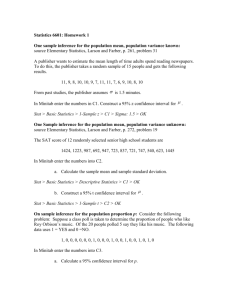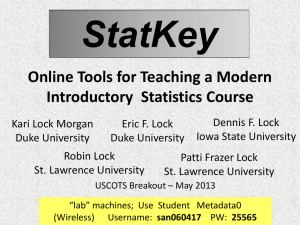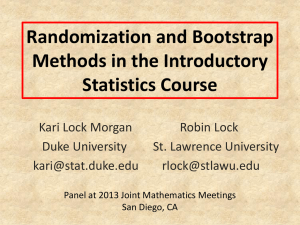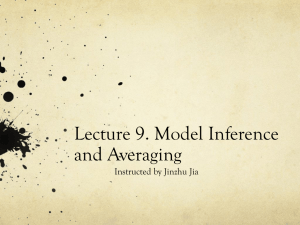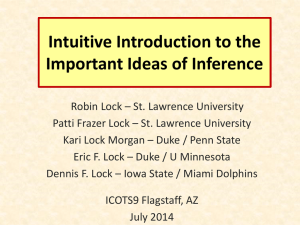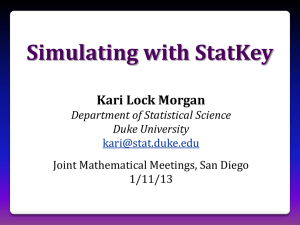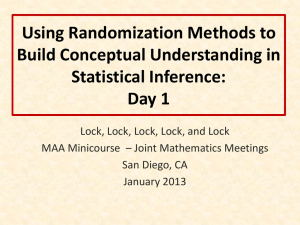- Unlocking the Power of Data
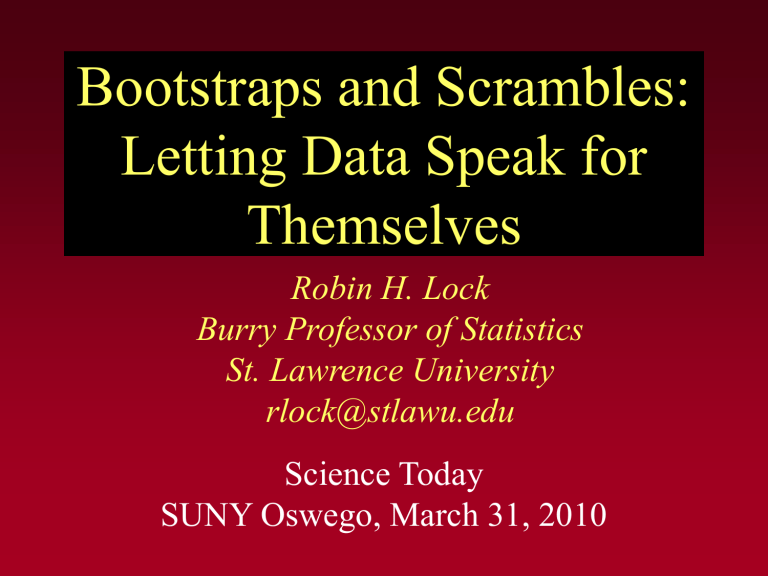
Bootstraps and Scrambles:
Letting Data Speak for
Themselves
Robin H. Lock
Burry Professor of Statistics
St. Lawrence University rlock@stlawu.edu
Science Today
SUNY Oswego, March 31, 2010
Bootstrap CI’s &
Randomization Tests
(1) What are they?
(2) Why are they being used more?
(3) Can these methods be used to introduce students to key ideas of statistical inference?
Example #1: Perch Weights
Suppose that we have collected a sample of
56 perch from a lake in Finland.
Estimate and find 95% confidence bounds for the mean weight of perch in the lake.
From the sample: n =56 X =382.2 gms s =347.6 gms
Classical CI for a Mean (μ)
“Assume” population is normal, then
X
s
~ t n
1 n
X
t
* n
1 s n
For perch sample:
382 .
2
2 .
004
347 .
6
56
382 .
2
2 .
004
46 .
5
382 .
2
93 .
1
(289.1, 475.3)
Possible Pitfalls
What if the underlying population is NOT normal?
Perch Dot Plot
200 400 600
Weight
800 1000
What if the sample size is small?
What is you have a different sample statistic?
What if the Central Limit Theorem doesn’t apply?
(or you’ve never heard of it!)
Bootstrap
Basic idea: Simulate the sampling distribution of any statistic (like the mean) by repeatedly sampling from the original data.
Bootstrap distribution of perch means:
• Sample 56 values (with replacement) from the original sample.
• Compute the mean for bootstrap sample
• Repeat MANY times.
Original Sample (56 fish)
Bootstrap “population”
Sample and compute means from this “population”
Bootstrap Distribution of 1000 Perch Means
Dot Plot Measures from Sample of Perch
250 300 350 400 xbar
450 500 550
CI from Bootstrap Distribution
Method #1: Use bootstrap std. dev.
X
z * S boot
For 1000 bootstrap perch means: S boot
=45.8
382 .
2
1 .
96
45 .
8
382 .
2
89 .
8
( 292 .
4 , 472 .
0 )
CI from Bootstrap Distribution
Method #2: Use bootstrap quantiles
Measures from Sample of Perch Dot Plot
2.5%
250 300
299.6
350 400 xbar
95% CI for μ
450
476.1
500
2.5%
550
Butler & Baumeister (1998)
Example #2: Friendly Observers
Experiment: Subjects were tested for performance on a video game
Conditions:
Group A: An observer shares prize
Group B: Neutral observer
Response: (categorical)
Beat/Fail to Beat score threshold
Hypothesis: Players with an interested observer
(Group A) will tend to perform less ably.
A Statistical Experiment
Friendly Observer Results
Group A
(share prize)
Group B
(prize alone)
Beat Threshold 3 8 11
Failed to Beat
Threshold
9 4 13
12 12
Is this difference “statistically significant”?
Friendly Observer - Simulation
1. Start with a pack of 24 cards.
11 Black (Beat) and 13 Red (Fail to Beat)
2. Shuffle the cards and deal 12 at random to form Group A.
3. Count the number of Black (Beat) cards in
Group A.
Automate this
4. Repeat many times to see how often a random assignment gives a count as small as the experimental count (3) to Group A.
Friendly Observer – Fathom
Computer Simulation
48/1000
Automate: Friendly Observers Applet
Allan Rossman & Beth Chance http://www.rossmanchance.com/applets/
Observer’s Applet
Fisher’s Exact test
P( A Beat < 3)
12
0
12
11
24
11
12
1
12
10
24
11
12
2
12
9
24
11
12
3
12
8
24
11
0 .
000005
0 .
00032
0 .
0058
.
04363
P ( A Beat
3 )
0 .
0498
Example #3: Lake Ontario Trout
X = fish age (yrs.)
Y = % dry mass of eggs n = 21 fish r = -0.45
Is there a significant negative association between age and % dry mass of eggs?
H o
:ρ=0 vs. H a
: ρ<0
PctDM <new>
Randomization Test for
Correlation
•Randomize the PctDM values to be assigned to any of the ages (ρ=0).
•Compute the correlation for the randomized sample.
•Repeat MANY times.
•See how often the randomization correlations exceed the originally observed r =-0.45.
Randomization Distribution of
Sample Correlations when H o
:ρ=0
Measures from Scrambled FishEggs Dot Plot
26/1000
-0.6
-0.4
r =-0.45
-0.2
0.0
r
0.2
0.4
0.6
Confidence Interval for Correlation?
Construct a bootstrap distribution of correlations for samples of n =20 fish drawn with replacement from the original sample.
Bootstrap Distribution of
Sample Correlations
Measures from Sample of FishEggs Dot Plot
-0.8
r =-0.74
-0.6
-0.4
r
-0.2
0.0
r =-0.08
0.2
Bootstrap/Randomization Methods
• Require few (often no) assumptions/conditions on the underlying population distribution.
• Avoid needing a theoretical derivation of sampling distribution.
• Can be applied readily to lots of different statistics.
• Are more intuitively aligned with the logic of statistical inference.
Can these methods really be used to introduce students to the core ideas of statistical inference?
Coming in 2012…
Statistics: Unlocking the Power of Data by Lock, Lock, Lock, Lock and Lock
